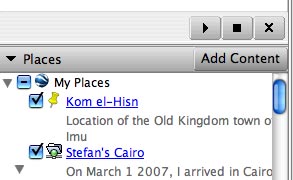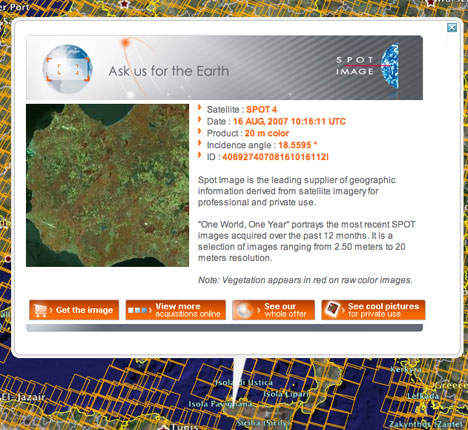Two updates to Google Earth to mention quickly before heading off for a night on Stockholm town celebrating the sixth anniversary of the Swedish blogosphere (they keep good track of such things here:-):
- Fire up your copy of Google Earth 4.2 Beta to notice an “Add Content” button in the Places sidebar pane. It takes you to the Google Earth Gallery, where plenty more KML awaits. This allows Google to promote content by making it more accessible from within Google Earth. It doesn’t provide quite the same impact as getting a coveted default layer in the Layers pane, but it’s a nice boost nonetheless. (Via Google Lat-Long Blog, which also points us to the submission form for Google Earth Gallery.)

- DigitalGlobe’s coverage of the Earth has long been indicated by a default layer. Now another remote sensing content provider, France’s Spot Image, gets its default layer. The tile outlines show all imagery collected over the past year, and the associated popup lets you click through to an ordering screen.
At 2.5m-20m per pixel, the resolution isn’t nearly as detailed as DigitalGlobe’s, but the coverage is more complete and usually more up-to-date. Ordering prices are ‚Ǩ1,900-‚Ǩ8,100 per image for the ones I checked, so this is only useful for institutions, whose employees can now of course use Google Earth 4.2 Free at work legally.

The SPOT imagery doesn’t seem to be useful for a normal Google Earth user.
Anyway, rest of the European countries missing province borders have finally been updated!
Dunkleosteus – you’re right. The cool thing with the DigitalGlobe layer is that it gives you a tool to correlate dates with their image tiles, so you can do some forensic mapping, and that doesn’t seem possible with the Spot Image layer.
However, I have just been told to expect more “consumer” layers from Spot Image in the future, so it will be interesting to see what that implies.
The layers serve two distinct potentials, in my mind.
1) Showcase the ability of Google Earth to become a robust distribution gateway for imagery vendors, product specialists, etc.
2) Eliminating the barriers to smaller interests who can find a use for the imagery (propogation by awareness).
The more that people are ‘turned-on’ and ‘tuned-in’ how to approach the data sources — the greater potential for uses to be found, with an advantage to generating new vertical intiatives.
With that said — hopefully this kind of approach can generate enough interest that it ultimately lowers the price of data, as opposed to increasing it. (Elimination of costs within the chain of acquisition from the library [customer to vendor], and streamlining of the distribution process [vendor to customer].)